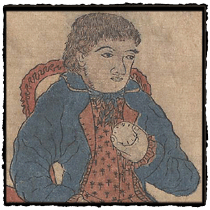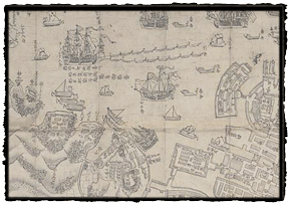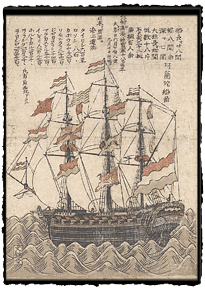 Foreigners and Disease
by Laura W. Allen
Foreign traders were often blamed for introducing new diseases to Japan. A
number of prints depicting foreigners, their ships, and the foreign communities in the port
cities of Nagasaki, and later, Yokohama, are included in the collection. Anxiety about
the malign influence of foreigners was among the factors leading the seventeenth-century
Tokugawa shoguns to isolate Japan through policies sharply restricting contact with the
outside world. Cholera does seem to have arrived in Japan via ships landing in Nagasaki,
so these fears were not altogether unfounded.
Although Ieyasu (1543-1616), the first Tokugawa shogun, encouraged foreign
trade, during the 1630s and 1640s the third, Iemitsu (1604-51) effectively closed the
country's borders through a series of exclusion decrees. From that point until the mid-nineteenth century, most Japanese subjects were prohibited from leaving the country, and
the only foreign traders allowed to conduct business in Japan were a small number of
Dutch and Chinese men who were confined to the island settlement of Dejima, located in
Nagasaki Bay. Nagasaki, a port on the southern island of Kyushu, was located at a safe
remove from the Edo capital.
 Printed maps of Nagasaki show the location of Dejima clearly: a man-made island
shaped like a fan, it projects into the harbor, isolated from the town, to which it is linked
only by a single, narrow bridge. In one map dating to 1778, the hills surrounding the
town are depicted from a traditional, omniscient viewpoint, so that the peaks at the
bottom of the map (the southeast side of the harbor) appear to be upside down. Printed maps of Nagasaki show the location of Dejima clearly: a man-made island
shaped like a fan, it projects into the harbor, isolated from the town, to which it is linked
only by a single, narrow bridge. In one map dating to 1778, the hills surrounding the
town are depicted from a traditional, omniscient viewpoint, so that the peaks at the
bottom of the map (the southeast side of the harbor) appear to be upside down.
The maps suggest the ease with which foreigners could be contained within this
deep harbor: after navigating a narrow passage to enter, the ships and their sailors found
themselves facing a substantial town, whose Japanese population outnumbered the
residents of Dejima by at least ten to one. Each of the maps in the collection also
carefully details the appearance of the foreign ships in the harbor.
 Interest in the ships could also be satisfied by more precisely detailed, close-up
images. One print shows the exotic features of a ship's design, including the nine
long guns projecting through the open portholes, the figurehead, the mullion windows at
the bow, and the three masts, outfitted with an array of sails and pennants (the colors on
this print are faded, so that the blue stripes of the Dutch flag, like the waves, now read as
gray). The vast scale of the ship is emphasized by the minute size of the sailors, just
barely visible on board. Above the ship are inscribed its vital statistics (length, height,
depth, and so on), and the distances, in leagues, to various foreign capitals, from Taiwan
to Russia. Interest in the ships could also be satisfied by more precisely detailed, close-up
images. One print shows the exotic features of a ship's design, including the nine
long guns projecting through the open portholes, the figurehead, the mullion windows at
the bow, and the three masts, outfitted with an array of sails and pennants (the colors on
this print are faded, so that the blue stripes of the Dutch flag, like the waves, now read as
gray). The vast scale of the ship is emphasized by the minute size of the sailors, just
barely visible on board. Above the ship are inscribed its vital statistics (length, height,
depth, and so on), and the distances, in leagues, to various foreign capitals, from Taiwan
to Russia.
|
|
|

